Page 7
12 - General Procedures
Short and open circuit operation – Differences:
The FF310 FaultFinder set uses two different types of signals to trace either short or open
circuits. Understanding its differences, as explained in the following paragraphs will allow
you to make the most effective use of this versatile tool.
12.1 Working with open circuits
On detection of an open circuit, the FF310T injects a special radio signal into the circuit,
which can be picked up by the FF310R’s sensor.
When tracing an open circuit, keep in mind that RF (radio frequency) signals injected in the
faulty wire being traced, will be easily absorbed by any other conductor nearby. (e.g.: other
wires, metal frames).The effect of this absorption may vary from a reduction in the FF310R’s
range, to a total shielding of the signal with no detection being possible at all (See Fig. 6).
Fig. 6 - Detection fi eld when tracing open circuit with the FF310R
In order to avoid confusing a shielded portion of the faulty wire with the actual fault on it,
the circuit should be checked on in several places to confi rm that no signal is detected
on the other side of the suspected faulty section.
12.2
Working with short circuits (and tracing circuits)
When the FF310T detects a short circuit (or closed circuit), it injects pulses of electrical
current in the wires, which generate magnetic fi elds. Unlike radio signals, magnetic fi elds
are not easily absorbed by nearby conductors and therefore can be picked up by the
FF310R’s sensor in a wider range of situations (See Fig. 7).
Fig. 7 - Detection fi eld when tracing short-circuits with the FF310R

